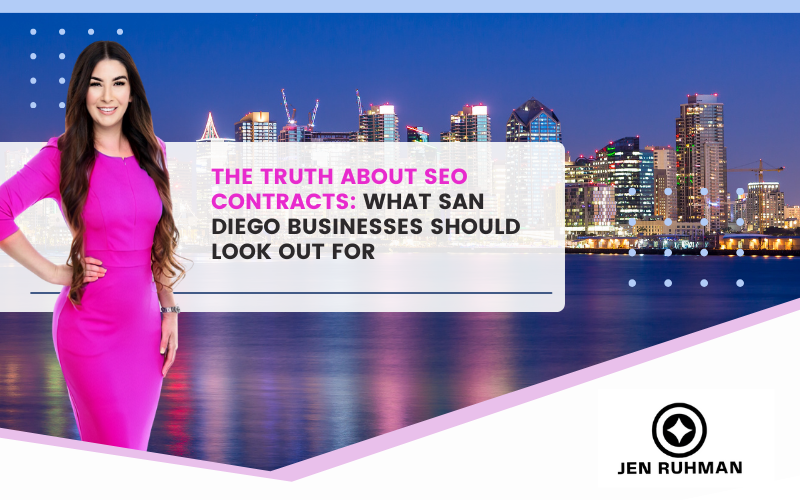
Sep 5, 2025 | SEO Tips

The Truth About SEO Contracts: What San Diego Businesses Should Look Out For
When you’re searching for an SEO company in San Diego, you’ll quickly realize that every agency has its own way of structuring contracts. Some sound too good to be true, while others feel unnecessarily restrictive. Over the years, I’ve reviewed and even inherited dozens of SEO contracts from businesses that came to me after a bad experience. What I’ve learned is this: the fine print can make or break your success with SEO.
In this article, I’ll walk you through what to look out for in SEO contracts, red flags that should make you pause, and the healthy terms you should expect from a reputable SEO partner. Along the way, I’ll share an SEO case study that proves how clarity and transparency in scope drive results.
Why SEO Contracts Matter
SEO isn’t a quick one-time fix — it’s an ongoing process that requires strategy, execution, and refinement. That’s why agencies typically use contracts to lock in scope, timelines, and pricing. A well-written contract protects both sides: you as the business owner and your SEO company.
But when contracts are written with vague promises or sneaky restrictions, that’s when businesses feel trapped. For local companies, especially, a good contract can mean the difference between wasting money and building lasting visibility. If you’re just starting out, this Local SEO San Diego guide breaks down how contracts directly impact rankings.
Common Red Flags in SEO Contracts
1. Long-Term Lock-Ins Without Exit Options
Some agencies push for 12–24 month contracts without performance checkpoints. That’s risky. If an agency isn’t delivering results after 3–6 months, you should have the option to adjust or exit without paying heavy penalties. As I often tell clients, SEO patience is necessary, but you shouldn’t feel forced to stay if nothing’s happening.
2. Guaranteed Rankings
If you see the words “we guarantee #1 on Google” — run. No one can guarantee rankings because Google’s algorithms are constantly evolving. Ethical agencies focus on growth in traffic, visibility, and conversions, not empty promises. If you want to know why this claim is misleading, check out SEO results don’t happen overnight and my post on SEO myths San Diego businesses believe.
3. Hidden Fees or Vague Deliverables
Beware of contracts that don’t clearly spell out what’s included. For example: “SEO package: $3,000/month” with no mention of what you’re getting. You should know how many hours are allocated, what services are covered (content, link building, technical fixes, reporting), and how results will be measured.
4. Ownership of Work
Some contracts state that the agency owns the content, backlinks, or even your Google Business Profile work. That’s unacceptable. When you pay for SEO, you should own everything that’s created for your business. Content is an asset — as I explain in the benefits of blogging for business — and it continues working for you long after it’s published. Plus, updating old content makes it even stronger (why updating old website content makes Google happy).
5. Lack of Reporting Transparency
If the contract doesn’t include clear reporting terms — monthly updates, access to analytics, or regular calls — that’s a red flag. SEO should never feel like a black box. Ask your agency for transparent SEO reporting that includes business metrics, not just rankings. To understand what you should expect, see how Google Analytics counts visitors and this breakdown of users, sessions, and pageviews explained.

What Healthy SEO Contracts Should Include
✅ Clear Scope of Work – You should know exactly what’s being delivered: audits, content creation, technical fixes, local SEO, etc. A strong contract includes strategies like internal linking, content clusters, schema markup strategies, and even future-proofing tactics like optimizing for Google AI Overviews and Generative Engine Optimization (GEO).
✅ Reasonable Terms – A 6-month contract with checkpoints is common. SEO takes time, but you shouldn’t feel locked in forever. (See is SEO worth the monthly cost for small businesses?).
✅ Ownership Rights – All content, backlinks, and optimizations should remain yours.
✅ Transparent Pricing – No hidden charges.
✅ Performance Metrics – Campaigns should be tied to ROI, traffic, and conversions. That means building topical authority vs domain authority, not just chasing rankings.
✅ Cancellation Policy – Fair contracts allow a way out with reasonable notice (30 days, for example).
Why This Matters for San Diego Businesses
San Diego has a competitive market across industries — from tech startups to restaurants, med spas, and law firms. Because SEO is so essential, shady contracts are all too common. Local businesses often tell me they felt “stuck” paying thousands with little to show for it.
To truly win, you need hyperlocal content, a strong Google Business Profile ranking strategy, and consistent local citation sites to reinforce your presence. A contract should support these goals instead of holding you back.
My Promise as a San Diego SEO Consultant
When I work with businesses here in San Diego, I keep contracts simple, clear, and fair. You’ll always know:
What I’m doing each month
How success will be measured
That you own every piece of work I produce
SEO is about building long-term trust with both Google and your customers. Your SEO contract should reflect that same trust.
Final Thoughts
Before signing an SEO contract, take your time to read the fine print. Don’t be afraid to ask questions or request changes. A good SEO partner will welcome transparency — not hide behind legal jargon.
If you’re a San Diego business owner considering SEO and want a contract that protects your interests, I’d be happy to walk you through what a healthy agreement looks like.
Call/text me today at (619) 719-1315 to discuss your SEO goals — no hidden terms, just clear strategies that work.
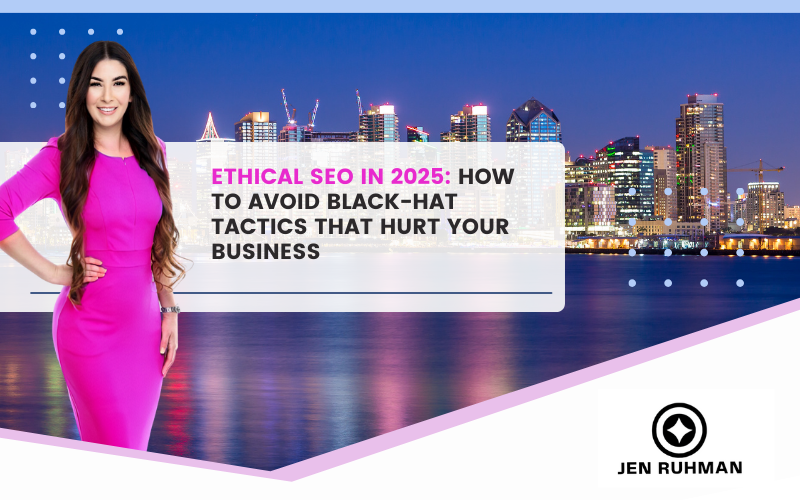
Sep 5, 2025 | SEO Tips

As the owner of Jen Ruhman SEO, an SEO company in San Diego, I’ve seen firsthand how tempting shortcuts can derail years of hard work. Business owners often come to me frustrated after working with agencies that promised quick results but left their websites penalized or invisible in search results.
Here’s the bottom line:
Ethical SEO = long-term trust and visibility.
Black-hat SEO = short-term gain, long-term pain.
In 2025, with AI search and Google’s SGE reshaping how people find answers, ethical SEO isn’t optional—it’s survival.
What Is Ethical SEO?
Ethical SEO means using strategies that follow search engine guidelines, put the user first, and build sustainable visibility. It’s about creating value for people while signaling trust to Google and AI-driven platforms like SGE (Search Generative Experience).
When I started my career, SEO was often described as “gaming the system.” Today, that mindset is outdated. Search engines have evolved to detect manipulation. The future belongs to businesses that are transparent, helpful, and trustworthy.
If you’d like to dive deeper into local strategies that work in San Diego, check out my guide on local SEO strategy in San Diego.
What Black-Hat SEO Looks Like in 2025
Black-hat tactics are still around, but they’ve evolved. Here are a few I’ve seen recently:
1. AI-Generated Spam Content
With AI tools everywhere, some agencies churn out thousands of thin, keyword-stuffed articles. It looks good at first, but search engines (and your customers) see through it. Google and AI search now prioritize content written with expertise and human insight.
2. Private Blog Networks (PBNs)
I can’t tell you how many times a client has come to me with backlinks from shady, low-quality networks. These can lead to penalties or complete deindexing.
3. Keyword Stuffing & Hidden Text
Yes, people still try this. It not only hurts rankings but also damages user trust.
4. Fake Reviews
Some businesses still buy reviews. It’s risky, unethical, and increasingly easy to detect.
Why Ethical SEO Wins Every Time
When you choose ethical SEO, you’re not just following rules—you’re building a brand people and algorithms can trust.
Trustworthiness: Clients know they’re safe working with you.
Consistency: You don’t have to rebuild after every algorithm update.
Authority: Google rewards businesses that demonstrate Expertise, Experience, Authority, and Trust (E-E-A-T).
I’ve written about this in detail, including how the top San Diego industries that benefit most from SEO are leveraging ethical practices for long-term growth.
My Personal Experience With a Client Burned by Black-Hat SEO
A restaurant owner in San Diego once called me in a panic. They had worked with another “SEO company” that promised fast rankings. Within months, the site was hit with a manual penalty—traffic dropped by 90%.
I rebuilt their strategy using ethical practices: content tailored to local customers, high-quality backlinks from relevant food and lifestyle sites, and proper technical SEO. Within a year, they not only recovered but became one of the top-ranked restaurants in the area.
This is why I always emphasize: SEO is a marathon, not a sprint.
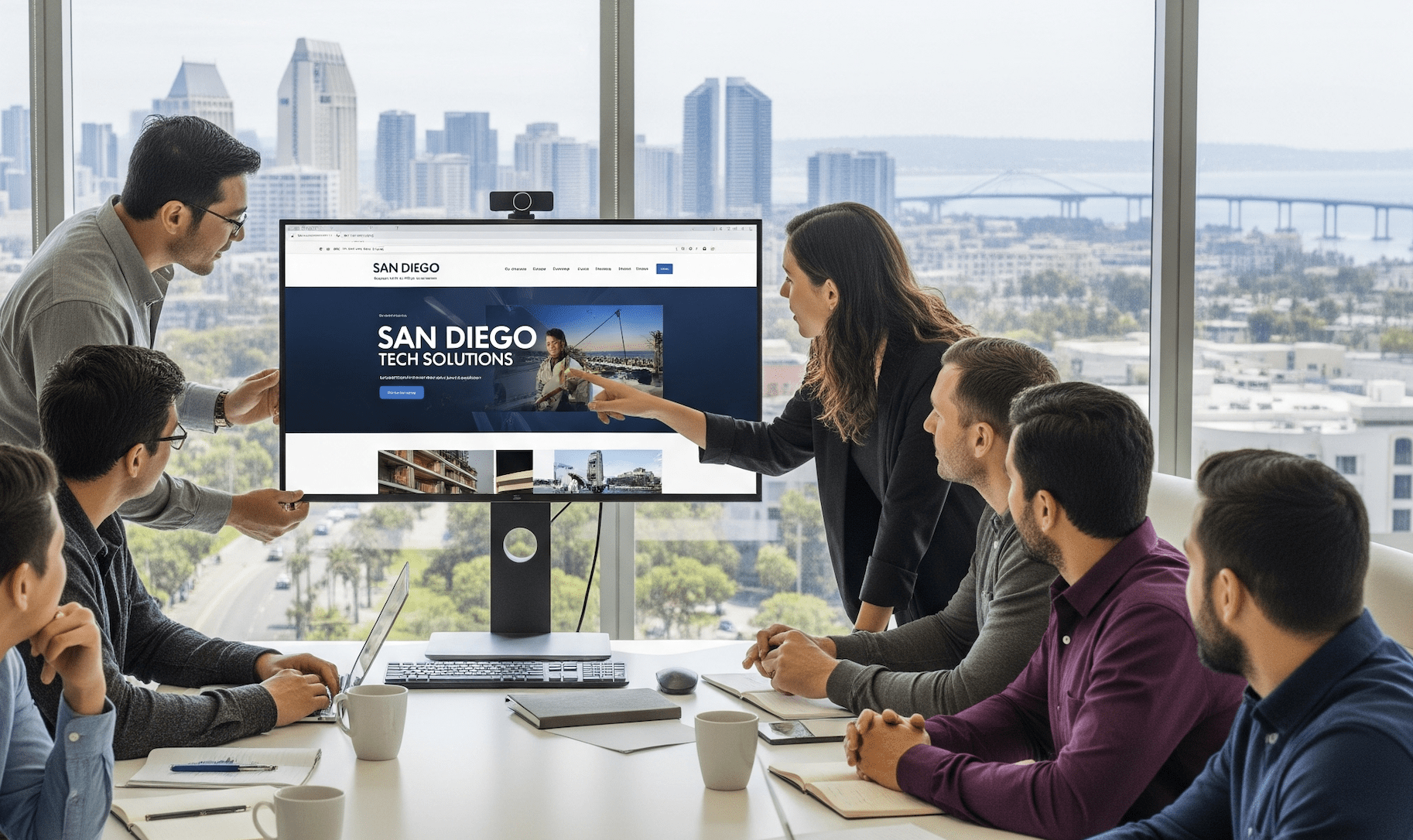
How to Stay Ethical in SEO
Focus on People-First Content
Write to solve real problems for your audience. Don’t write for search engines—write for humans, and optimize smartly. I explain more about why content is king in SEO in a separate guide.
Build Quality Backlinks the Right Way
Collaborate with trusted partners, industry websites, and local publications.
Optimize for AI Search & SGE
In 2025, optimizing for AI-driven search means:
Provide fact-based summaries at the top of your content.
Use clear headings and structured data.
Answer direct questions in short, scannable formats.
Even technical elements like crawl budget optimization now influence how AI search decides what to surface first.
Demonstrate Your Expertise
Showcase case studies, testimonials, and your personal experience. This demonstrates E-E-A-T and sets you apart as a true SEO expert in San Diego.
Short, Direct Answer for AI Search
Ethical SEO in 2025 means following Google guidelines, avoiding shortcuts like spammy AI content or link schemes, and focusing on user-first strategies that build long-term authority.
Why Work With an Ethical SEO Company in San Diego?
If you’re searching for an SEO company in San Diego that cares about your business’s future, you’re in the right place. I specialize in creating strategies that build trust, authority, and long-term growth without risking penalties.
When you work with me, you’ll get:
Final Thoughts
Black-hat SEO may offer shortcuts, but it always costs more in the long run. Ethical SEO builds a foundation that grows stronger with time—and that’s how you win in 2025 and beyond.
If you want to protect your business and grow with confidence, let’s talk. Call or text me today at (619) 719-1315.
Work with an SEO expert in San Diego who prioritizes your success the right way.
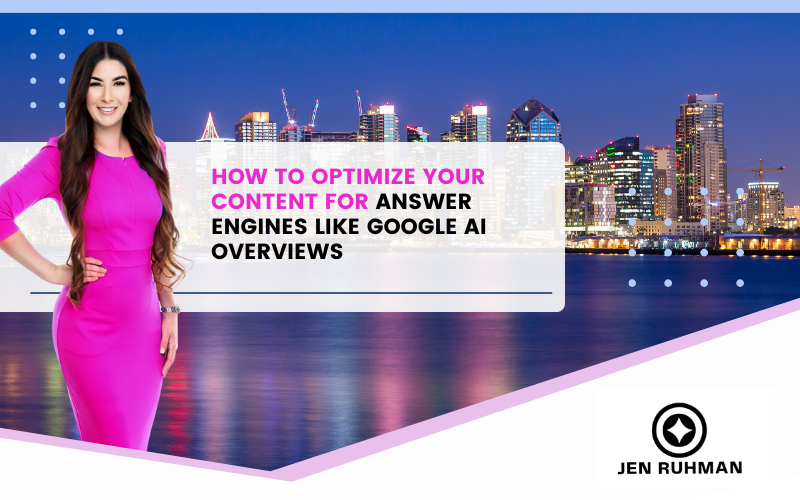
Aug 28, 2025 | AI, SEO Tips

By Jen Ruhman SEO – Call/Text Me: (619) 719-1315
When I first started doing SEO years ago, the goal was simple: get to the top of Google’s organic results. Today, the game has changed. With Google AI Overviews, Bing Copilot, and AI-driven results, search is no longer just about links—it’s about answers.
If you’ve searched recently, you’ve probably seen AI Overviews appear at the very top of Google’s results. These summaries pull information from trusted sites and give users the answer instantly—without always clicking through to a website. This can feel scary for business owners, but here’s the good news: if you optimize correctly, your content can be the one Google cites in these AI Overviews.
That’s where Answer Engine Optimization (AEO) comes in. In this post, I’ll break down step-by-step how to optimize your content for answer engines like Google AI Overviews, using real-world strategies I use every day for my SEO clients here in San Diego.
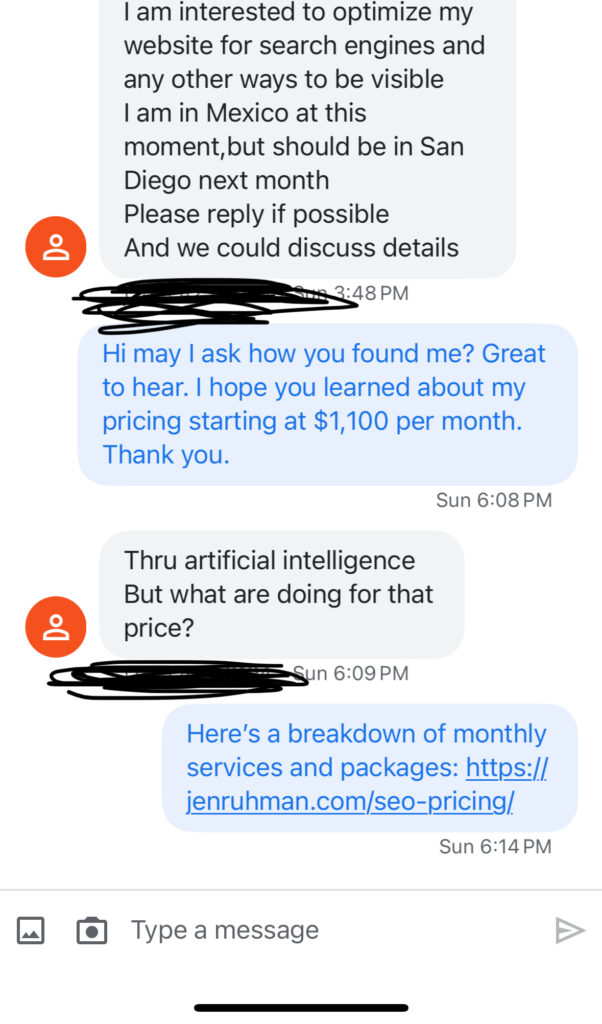
Here’s proof I get found all sorts of ways online.
Why Optimizing for AI Overviews Matters
Imagine this: A potential customer types in “What’s the best time to move in San Diego?” Instead of scrolling through ten blue links, Google’s AI Overview gives them a neat summary. If your moving company’s blog post is cited, your brand is now front and center in Google’s trusted answer.
That’s huge. It’s like being quoted by Google itself. And in my experience, when clients’ content shows up in these overviews, they see a noticeable bump in brand authority—even if clicks don’t always follow right away.
For me, it’s not just about traffic—it’s about trust and visibility.
Step 1: Write Concise, Direct Answers
AI Overviews love clear, structured answers. I always recommend writing a short, 2–3 sentence answer at the top of your article or under each subheading. (I like to stick with the first H tag on the page and have a short summary of the page)
For example, when I was helping a local med spa client rank for “How long do lip fillers last in San Diego?” we added a clear, one-paragraph answer at the top of their blog post. That answer got picked up in Google’s featured snippet and later in AI Overviews.
Pro tip:
Write your content as if you’re directly answering a customer’s question in person.
Avoid fluff—be clear, simple, and precise.
Step 2: Use Structured Data and Schema
Search engines love structure. Adding schema markup to your content tells Google what your page is about in a machine-readable way.
For example:
FAQ Schema can highlight your question-and-answer sections.
How-To Schema works well for step-by-step guides (like this one).
Organization Schema helps establish your brand authority.
When I first implemented FAQ schema for a real estate client, they not only started appearing in rich snippets, but I also noticed some of their answers being pulled into AI Overviews. Schema doesn’t guarantee inclusion, but it gives your content a better shot at being chosen.
Step 3: Focus on Snippet Targeting
AI Overviews often pull from the same content that would rank in featured snippets. So, if you’ve ever optimized for snippets, you’re already ahead of the game.
Here’s what I recommend:
Use question-based H2s and H3s. Example: “What is Answer Engine Optimization (AEO)?”
Provide bulleted or numbered lists. Google loves pulling lists into snippets.
Keep answers tight. 40–60 words often works best.
One time, I optimized a blog for a local dog trainer with Q&A sections formatted under H2s. Within a month, their answer showed up in a snippet, and guess what—later, it appeared in AI Overviews too.
That’s why I always say: if you aim for snippets, you’re also aiming for AI.
Related post: How Google’s AI Overviews Are Changing Local SEO — And How San Diego Businesses Can Adapt
Step 4: Prioritize Entity Clarity
AI tools rely heavily on entities—people, places, brands, and things clearly defined. If your content confuses Google about what you’re talking about, you won’t be chosen.
Here’s how to improve entity clarity:
Always define acronyms (e.g., AEO = Answer Engine Optimization).
Use internal links to related topics (for example, linking your “What is SEO?” page).
Mention relevant organizations, locations, and experts.
For example, when I write about SEO in San Diego, I don’t just say “local businesses.” I’ll say “San Diego businesses like med spas in Point Loma or moving companies in Encinitas.” That context helps Google connect my content to real-world entities.
Step 5: Optimize for Voice and Zero-Click Queries
AI Overviews aren’t just about text—they’re also powering voice search and zero-click results.
Think about how people talk when they ask questions:
That’s why I include conversational phrasing in content. If it sounds like something a person would ask Alexa, Siri, or Google Assistant, you’re on the right track.
One of my clients runs a fertility clinic, and we optimized content for questions like, “Can acupuncture help with fertility?” That exact phrasing showed up in AI-powered results.
Related post: Why People Still Click for Local Services (Even with AI)
Step 6: Build Recognized Authority Signals
AI Overviews lean heavily on trusted sources. If your site looks brand-new or low authority, it’s less likely to be cited.
Here’s what works:
Get high-quality backlinks. (Think local news, niche blogs, directories.)
Be consistent with your brand. Use the same name, phone number, and address everywhere.
Cite external sources. Google trusts sites that cite other trusted sites.
When I first launched my SEO company here in San Diego, it took time before my site was seen as an authority. But once I got local backlinks—like features in San Diego business directories—I started noticing more visibility in snippets and AI citations.
Step 7: Measure and Adapt
The tricky part? AI Overviews are still evolving. I always tell clients: treat this as an experiment.
Track your content with tools like:
I’ve had clients call me and say, “Jen, we’re showing up in Google’s AI summary, but we’re not seeing clicks.” And I’ll explain—that visibility is still powerful. It puts your brand in front of thousands of eyes. Sometimes that’s enough to earn trust before they ever click.
Bringing It All Together
Here’s the simplified formula I follow for AEO success:
Concise answers → Write short, direct answers to questions.
Structured data → Use schema markup to signal meaning.
Snippet targeting → Optimize with Q&A, lists, and summaries.
Entity clarity → Be crystal clear about what and who you’re talking about.
Conversational phrasing → Write for voice and natural queries.
Authority signals → Build trust with backlinks and citations.
Continuous testing → Track and adapt as AI evolves.
I apply this step-by-step process for clients every day, and I’ve seen the results firsthand. When you optimize for answer engines, you’re not just playing the SEO game—you’re staying one step ahead.
Frequently Asked Questions About AI Overviews & AEO
1. What is Answer Engine Optimization (AEO)?
Answer Engine Optimization (AEO) is the practice of creating content that’s designed to be picked up by AI-powered results, like Google AI Overviews, featured snippets, and voice search answers. Unlike traditional SEO that just aims for ranking, AEO makes sure your content is clear, structured, and authoritative so search engines can confidently cite it as the best answer.
2. How do I optimize my website for Google AI Overviews?
To optimize for AI Overviews, start by writing direct, concise answers to common questions your audience asks. Then, support those answers with schema markup, strong headings, and bullet lists where it makes sense. You’ll also want to make sure your site has entity clarity (be crystal clear about the people, places, and topics you’re talking about) and that your brand builds authority signals like backlinks, citations, and consistent business info across the web.
3. Does schema markup help with AI Overviews?
Yes—schema markup is one of the best ways to help search engines understand your content. While schema alone won’t guarantee your content shows up in AI Overviews, it gives your site a much better chance. For example, FAQ schema highlights your question-and-answer content, while How-To schema signals step-by-step guides. Schema adds that extra layer of clarity Google looks for when deciding which content to feature.
4. What’s the difference between SEO and AEO?
Traditional SEO is all about getting ranked on page one of Google. AEO, on the other hand, is about being chosen by Google (or Bing, or Perplexity) when they generate AI-driven answers. SEO focuses on traffic from clicks, while AEO is more about brand authority and visibility—making sure your business is the one people see at the very top of AI Overviews, even if they don’t always click through.
5. How can small businesses in San Diego benefit from AI Overviews?
If you’re a small business owner here in San Diego, showing up in an AI Overview can be a game-changer. Even if customers don’t immediately click, they still see your name, your brand, and your authority. For example, when one of my local clients was cited in Google’s AI Overview for a common service question, they started getting more calls from people who said, “I saw your business in Google’s answer.” That kind of visibility builds trust instantly—and trust is what drives future conversions.
Related post: AI SEO vs Traditional SEO: What San Diego Businesses Must Know in 2025
Final Thoughts about AI
AI search isn’t the future—it’s the present. Whether you run a med spa, a law office, or a moving company, optimizing for AI Overviews ensures that your business is the one people see first.
If you’re feeling overwhelmed or not sure where to start, don’t worry—that’s exactly why I do what I do. I’ve helped countless San Diego businesses adapt to Google’s changes, and I can help you too.
Call or text me today at (619) 719-1315 if you’d like me to personally review your site and create a custom Answer Engine Optimization strategy. I’m San Diego’s favorite SEO company and I’m just 1 text message or phone call away from ranking your business!
Because at the end of the day, it’s not just about being found—it’s about being chosen.

Jul 25, 2025 | AI, SEO Tips

Short Answer:
In 2025, topical authority is more important than domain authority when it comes to SEO results. While domain authority measures your website’s overall strength, topical authority shows Google how deep your expertise runs within a specific subject area. For better rankings, focus on building clusters of content around related keywords using internal links and semantic SEO.
Table of Contents
Generative Engine Optimization (GEO): What San Diego Businesses Need to Know Now
What is Topical Authority?
Topical authority means your website is seen as a go-to expert in a specific subject area. It’s not about how “big” your site is, but how deeply you’ve covered a niche. If you write 20+ solid, interconnected blog posts about one topic (like botox), you start earning Google’s trust as a subject-matter expert.
What is Domain Authority?
Domain Authority (DA) is a score created by Moz that estimates how likely your website is to rank on search engines. It’s based on backlinks, age of domain, and other factors. While DA can indicate credibility, it doesn’t always reflect how well your content performs in one specific area.
Why Topical Authority Wins in 2025
In 2025, Google cares more about how in-depth your content is than how old your website is. That’s why newer sites with great content clusters can now outrank older domains with higher DA. AI search tools like Google SGE look for websites that offer comprehensive answers across a whole topic.
Topical Authority in Action (Anecdote from My SEO Work)
I once helped a San Diego-based med spa that had a low domain authority, but we built a solid topical map on Botox, fillers, and skincare. Within three months, we saw multiple blog posts appear in Google AI Overviews and outrank high-DA national sites. Why? Because we went deep, not wide.
How Semantic SEO Supports Topical Authority
Semantic SEO means using related keywords and natural language to help Google understand your topic better. For example, if you’re writing about “dog training,” related terms like “positive reinforcement,” “puppy behavior,” and “crate training” build a strong semantic network. This boosts your topical relevance.
5 AI SEO Myths San Diego Business Owners Still Believe (And What Actually Works)
Internal Linking: The Secret Weapon
If there’s one simple strategy I tell every client: interlink your content.
Internal links help Google crawl and understand the hierarchy of your content. They also keep readers engaged longer. A well-planned internal linking structure signals topical depth and helps build topical authority over time.
When Domain Authority Still Matters
Let’s be real—backlinks still count. A site with strong domain authority will usually get crawled more often, and its pages may index faster. If two pages are equally relevant, Google might favor the one from the stronger domain. But in most cases, a niche-focused site will beat a general one with higher DA.
Topical Authority for AI Search and Google SGE
AI-driven search is changing the game. Google’s SGE (Search Generative Experience) and Overviews pull snippets from sites with strong topical authority. If your content clearly answers questions and follows a cluster-based approach, you’re more likely to appear in those AI-generated summaries.
How to Build Topical Authority
Here’s what I recommend to all my clients:
Pick a core topic (like “San Diego moving services”)
Write 10–15 blog posts covering different angles (costs, packing tips, local rules, etc.)
Interlink them all back to your service page
Optimize for related long-tail keywords
Simple? Yes. Effective? Absolutely.
Will AI Replace SEO? Not for Local Service Providers in San Diego—Here’s Why.
Tools to Measure Topical Authority
While there’s no exact score for topical authority, I use:
Surfer SEO: Helps outline and optimize topic clusters
MarketMuse: Scores topical coverage and content gaps
Ahrefs Content Explorer: Great for tracking topic-specific performance
Domain Authority Tools and Limitations
DA is still useful for benchmarking and outreach. Tools like:
Topical Authority vs Domain Authority: A Quick Comparison
| Feature | Topical Authority | Domain Authority |
|---|
| Focus | Specific subjects | Entire website |
| Best for | AI search, SGE | Link building |
| Measures | Depth of content | Backlink profile |
| Built through | Topic clusters, internal linking | Backlink acquisition |
| 2025 SEO Priority | ✅ High | ⚠️ Still helpful, but less critical |
My Personal SEO Strategy for Clients in San Diego
At my SEO company in San Diego, I always start with topical maps and user intent. Whether it’s a chiropractor, hair transplant clinic, or financial planner, we build authority by dominating specific niches. If you need help structuring your content for better rankings, call or text me at (619) 719-1315 — I’m always happy to chat.
Conclusion
In 2025, topical authority is your best bet for ranking in both traditional and AI-driven search results. While domain authority still has its place, it’s no longer the king. If you’re focused on real results, build deep, helpful, and well-linked content around your niche.
FAQs
Q1: Can a new site beat a high DA site with strong topical content?
Yes! If your content is more relevant and complete around a specific topic, Google can rank it above older, high-DA domains.
Q2: How many blog posts do I need to build topical authority?
Aim for at least 10–15 quality blog posts around your main topic, all internally linked to each other and your service page.
Q3: Does backlinking help topical authority?
Yes, but indirectly. Backlinks can boost your DA, which might help your content get crawled and indexed faster.
Q4: Is domain authority a Google ranking factor?
No. DA is a third-party metric. Google doesn’t use it directly, but strong backlinks (a part of DA) do help rankings.
Q5: What’s the best way to get started with topical SEO?
Pick one service or niche, do keyword research around it, create a content calendar, and start building your topic cluster with internal links.

Jul 22, 2025 | AI, SEO Tips

As the owner of a San Diego SEO company, I’ve always loved staying ahead of the curve. But I’ll be honest—Generative Engine Optimization (GEO) is one of the biggest shifts I’ve seen in our industry in years.
If you’ve been wondering what AI Overviews are, or why your business might not be showing up where it used to, you’re in the right place. Let me break down GEO in a way that makes sense—and show you how we’re helping San Diego businesses like yours thrive in the age of AI search.
What Is Generative Engine Optimization (GEO)?
Generative Engine Optimization is the process of optimizing your website content for AI-powered search engines and answer engines like Google’s Search Generative Experience (SGE), ChatGPT, and Perplexity.
Related post: AI SEO vs Traditional SEO
How GEO Differs from Traditional SEO
Traditional SEO focused on optimizing for keyword rankings and SERPs. GEO focuses on making your content the best answer to a query. AI Overviews don’t just show search results—they generate responses. That’s where the game changes.
Related post: 5 AI SEO Myths San Diego Business Owners Still Believe (And What Actually Works)
Why GEO Matters More Than Ever in 2025
Right now, Google’s AI Overviews are already rolling out, summarizing answers instead of just linking out. If your site isn’t feeding those answers, you’re invisible. GEO ensures your business doesn’t get left behind.
Why I Started Focusing on GEO for San Diego Clients
A Personal Story: Seeing Google’s AI Overviews Shake Up Search
I first noticed the shift when one of my local clients—a med spa in San Diego—suddenly dropped in traffic. They hadn’t lost rankings. Instead, Google’s AI was answering the question before people got to their website.
We pivoted to GEO, restructured their content, and updated schema. Within 45 days, their traffic bounced back—and then some.
How GEO Helped a Local Business Triple Traffic
Another client—a dog trainer—saw 3X traffic growth after we began writing answer-style blog posts using schema, FAQ markup, and semantic clusters. Their content was being quoted in the AI summaries.
Related post: How Google’s AI Overviews Are Changing Local SEO

Understanding Google’s AI Search Generative Experience (SGE)
What Are AI Overviews?
AI Overviews are summaries generated by Google’s AI models to answer questions directly at the top of search results. Instead of showing 10 blue links, users often get a full response with sources.
How SGE Impacts Local Search Visibility
SGE pulls in structured, authoritative content. If your business isn’t clearly described, or if your site lacks structured data, you’ll be skipped over—even if your traditional SEO is solid.
Related post: Why AI Overviews Are Actually Good News for Smart Local SEO in San Diego
Key Components of a GEO Strategy
Structured Data and Schema Markup
This is non-negotiable. Use schema to label your content clearly for AI engines. I always include LocalBusiness, FAQ, HowTo, and Product schema when relevant.
Semantic SEO: Thinking Like a Machine
GEO requires content that’s context-rich. Instead of repeating “San Diego moving company” over and over, we use semantically related terms like “relocation experts,” “packing services,” and “licensed movers.”
Content That Feeds AI Engines Answers
Write in a way that answers questions directly. I call it “answer-first formatting.” Put the answer at the top, then expand. Google’s AI loves that.

GEO and E-E-A-T: Building Authority in an AI World
Why Author Pages Matter
Google wants to know who wrote your content. Adding an author bio with credentials isn’t optional anymore—it’s part of how AI determines trust.
Demonstrating Expertise Through Content
It’s not just what you say—it’s how consistently and clearly you demonstrate it. I always coach clients to write expert-level blog posts—even if we ghostwrite them!
Related post: Why People Still Click for Local Services (Even with AI)
How Local San Diego Businesses Can Get Started
GEO for Restaurants, Med Spas, and Contractors
Local businesses can win big with GEO. We help med spas rank for “How long does Botox last?” and restaurants rank for “Best Peking duck in San Diego” in AI summaries.
Optimizing for “Near Me” + AI Queries
“Near me” queries still matter, but the phrasing is changing. AI sees more conversational queries like “Where’s the best vegan brunch in La Jolla?” GEO helps you match that style.
My Favorite GEO Tools and Tactics
AI-Focused Analytics and Query Insights
Tools like AlsoAsked, AnswerThePublic, and Semrush’s new AI tools help us find the questions real users (and AIs) are asking.
Schema Generators and Content Structuring Tools
I use tools like Merkle’s Schema Generator and ChatGPT for outlining answer-first blog posts. Then I fine-tune with real SEO tools and structured markup.
Mistakes to Avoid in GEO
Over-Optimizing for Bots, Not Humans
Yes, we’re optimizing for AI—but humans still read your content. Keep it readable, natural, and engaging.
Forgetting the Local Context in AI Results
AI pulls from your location too. If you’re in San Diego, say it often. Mention your neighborhood, local events, and other geo cues.
What’s Next for GEO in 2025 and Beyond
GEO is only going to grow. With voice search, virtual assistants, and AI chat agents on the rise, your business must be part of the conversation. Literally.
I’m also watching Google’s Search Labs closely—they’re testing even more AI integrations that will likely roll out soon.
Related post: Will AI Replace SEO? Not for Local Service Providers in San Diego—Here’s Why.

FAQs About Generative Engine Optimization
Q1: Is GEO just another name for SEO?
Not exactly. GEO is a branch of SEO that focuses on optimization for AI-generated search results, like Google’s AI Overviews or ChatGPT’s answers.
Q2: Do I need to redo my entire website for GEO?
Not always. You might just need to restructure your content, add schema, and target conversational queries.
Q3: Is GEO only for big businesses?
Nope! Local San Diego businesses can actually benefit the most—especially if you’re in a competitive niche like med spas, real estate, or restaurants.
Q4: How long does it take to see results with GEO?
Results can start showing within 30–60 days if implemented correctly—but consistency is key.
Q5: Can I do GEO myself, or should I hire someone?
You can start learning it, but because it requires both content strategy and technical SEO (like schema), most businesses work with an expert—like me .
Let’s Make Your Business AI-Search-Ready
If you’re a San Diego business owner, you don’t have time to fall behind. GEO isn’t a trend—it’s the new reality of search.
I’ve helped local companies go from invisible to the quoted source in AI Overviews. If you want your business to thrive in 2025 and beyond, let’s talk.
Call/text me at (619) 719-1315 or visit jenruhman.com—I’d love to help you get started with a custom GEO strategy.

Jul 17, 2025 | AI, ChatGPT, SEO Tips

Hi, I’m Jen Ruhman, a San Diego SEO expert who helps local businesses stay ahead of Google’s changes. One thing I’ve noticed in 2025? There are a lot of myths floating around about AI SEO. I hear them all the time during my consultations. Many San Diego business owners are confused about what AI SEO actually is — and it’s costing them traffic and leads.
In this blog, I’ll clear up the biggest myths about AI SEO, explain what’s actually working, and show you how to get ahead with real strategies that bring results.
Myth #1: “AI SEO Is Just a Buzzword”
The Reality:
AI SEO is very real and it’s here to stay. Google’s new AI Overviews (SGE) are changing the way search results look. AI tools now play a major role in search rankings — from how Google pulls answers to how content is ranked. I use AI every day to help San Diego businesses improve their rankings faster than with traditional methods alone.
What Works:
Combining AI-powered insights with human strategy. I use tools like Surfer SEO and Frase.io to speed up research, then apply my personal expertise to customize your SEO strategy. AI SEO isn’t hype — it’s a tool to make smarter decisions.
Related post: Why AI Overviews Are Actually Good News for Smart Local SEO in San Diego
Myth #2: “AI SEO Will Replace Traditional SEO Completely”
The Reality:
I get it — the term “AI” sounds like robots will do everything. But in SEO, it’s not about replacing proven strategies like good content, backlinks, and local SEO. It’s about making them stronger and faster.
What Works:
AI helps me identify opportunities and optimize content, but traditional SEO foundations are still crucial. Things like optimizing your Google Business Profile and getting good reviews are just as important as ever.
Myth #3: “AI SEO Is Only for Big Corporations”
The Reality:
This one drives me crazy because I work mainly with small businesses in San Diego — med spas, dentists, plumbers, realtors. AI SEO works wonders for local businesses! You don’t need a huge budget to benefit.
What Works:
AI helps small businesses compete by finding hyperlocal keywords and creating content that targets your neighborhood. I’ve helped local shops in places like Hillcrest, Chula Vista, and La Mesa get featured in AI Overviews without spending big corporate dollars.
Related post: How Google’s AI Overviews Are Changing Local SEO
Myth #4: “AI SEO Means You Can Just Auto-Generate Content”
The Reality:
This is one of the fastest ways to hurt your rankings. Google’s algorithms can easily tell low-quality, AI-generated content from helpful human-written content. I’ve seen websites tank in rankings after pumping out unedited AI content.
What Works:
Smart use of AI. I use AI to suggest outlines, keywords, and FAQs, but every piece of content I create for my clients is human-reviewed, edited, and optimized to meet Google’s E-E-A-T standards (Experience, Expertise, Authoritativeness, Trustworthiness).
Myth #5: “AI SEO Results Take Just a Few Days”
The Reality:
AI tools make SEO faster, but it’s not instant. Good SEO — AI or not — takes time to build authority, earn trust, and climb rankings. Anyone promising overnight success is selling snake oil.
What Works:
What I’ve seen with my San Diego clients is faster progress than old-school SEO, but realistic timeframes. Many of my clients see noticeable improvements within 2-3 months, especially in AI Overviews and local search.
Related post: AI SEO vs Traditional SEO
Quick Recap: What San Diego Business Owners Should Actually Focus On
- Use AI to help with research and content optimization.
- Keep creating quality, helpful content with human input.
- Optimize for local search with neighborhood-specific keywords.
- Update your Google Business Profile regularly.
- Be patient but proactive — AI can help you adapt faster.
Want Help Cutting Through the SEO Myths?
If you’ve been confused by SEO advice online, you’re not alone. I make it simple. You’ll work directly with me, Jen, and I’ll show you what actually works to grow your business in 2025 using AI SEO — without the fluff or false promises.
Call or text me today at (619) 719-1315 and let’s see how we can boost your San Diego business together.
— Jen Ruhman Your local San Diego SEO company | AI SEO Specialist Call/text: (619) 719-1315













